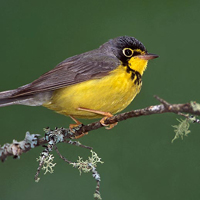Canada Warbler
Scientific name: Cardellina canadensis

Photo credit: Brian E. Small
Status
Special Concern
“Special Concern” means the species lives in the wild in Ontario, is not endangered or threatened, but may become threatened or endangered due to a combination of biological characteristics and identified threats.
Date added to the Species at Risk in Ontario List
September 10, 2009
Read the most recent assessment report (PDF).
What it looks like
The Canada Warbler is a small, brightly-coloured songbird. Males are more brightly coloured than females, with bluish-grey upperparts and tail and bright yellow underparts. The head is bluish with a black forehead and “sideburns,” which join to form a distinctive necklace of black stripes across its chest.
In the spring, males can be heard singing a distinctive song of clear, liquid notes ending emphatically.
Where it lives
The Canada Warbler breeds in a range of deciduous and coniferous, usually wet forest types, all with a well-developed, dense shrub layer. Dense shrub and understory vegetation help conceal Canada Warbler nests that are usually located on or near the ground on mossy logs or roots, along stream banks or on hummocks. It winters in South America.
In its wintering range in South America, the Canada Warbler prefers the dense shrub understories of mature cloud and rain forests, second-growth forests, as well as coffee plantations and farm field edges.
Where it’s been found in Ontario
The Canada Warbler only breeds in North America and 80% of its known breeding range is in Canada. Its primary breeding range is in the Boreal Shield, extending north into the Hudson Plains and south into the Mixedwood Plains. Although the Canada Warbler breeds at low densities across its range, in Ontario, it is most abundant along the Southern Shield.
What threatens it
A reduction in forests with a well-developed shrub-layer has likely impacted Canada Warbler throughout its breeding range. Canada Warbler likely faces extensive pressure on its wintering grounds in South America, where deforestation is a widespread problem.
Action we are taking
While special concern species do not receive species or habitat protection under the Endangered Species Act, 2007, the act requires us to prepare recovery guidance for special concern species, unless a recovery strategy or management plan is required for the species under the federal Species at Risk Act.
All species listed on the Species at Risk in Ontario List may be eligible for consideration for government funding through the Species at Risk Stewardship Program.
What you can do
Report a sighting
- Submit your observations of species at risk to the Natural Heritage Information Centre (NHIC), which is Ontario’s conservation data centre. Join the centre’s Rare Species of Ontario project in iNaturalist, an online plant and animal identification app, to quickly and easily submit your observations.
- Birds Canada is working to advance the understanding, appreciation and conservation of wild birds and their habitat in Ontario and elsewhere. For more information on how you can help, visit their website.
- As with all wildlife, don’t disturb or harass the birds or nesting sites. Be respectful and observe from a distance.
Volunteer
Volunteer with your local nature club or provincial park to participate in surveys or stewardship work focused on species at risk.
Be a good steward
- Private landowners have a very important role to play in species recovery. If you find species at risk on your land, you may be eligible for stewardship programs that support the protection and recovery of species at risk and their habitats, such as the Species at Risk Stewardship Program.
- As with many other rare plants and animals, the Canada Warbler is at risk due to the loss of forested areas. You can help by protecting any forests and surrounding natural vegetation on your property.
Report illegal activity
Report any illegal activity related to plants and wildlife to
Quick facts
- The Canada Warbler is difficult to observe in Canada because it lives in dense forest that is difficult to walk and see through.
- The Canada Warbler is one of the last migratory songbird species to arrive on Canadian nesting grounds in the spring and is also one of the first species to leave at the end of summer.